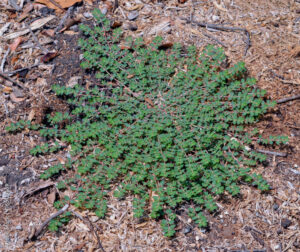
From 2008 through 2011, fourteen pre-emergent herbicides were tested across the United States through the IR-4 Ornamental Horticulture Program to determine whether they can control emerged weeds at the cotyledon to 1 leaf or 2 to 4 leaf stage. Three troublesome weeds were targeted initially including bittercress oxalis and spurge with Eclipta and Phyllanthus added later. Bittercress (Cardamine sp.) was controlled at the early postemergence application timings with Certainty at 0.035 and 0.094 lb ai/A, EXC3898 at 2.1 and 3.1 lb ai/A, Gallery 75 DF at 1.0 lb ai/A and V-10142 (imazasulfuron) at 0.38 and 0.75 lb ai/A. Emerged oxalis (Oxalis sp.) seedlings showed significant impact with early postemergence applications of Casoron 4G at 4 lb ai/A, Certainty at 0.035 and 0.094 lb ai/A, Gallery at 0.5 and 1.0 lb ai/A, indaziflam at 50 and 100 g/ha, SureGuard at 0.562 lb ai/A, Tower at 0.97 lb ai/A and V-10142 0.75 lb ai/A applications. Spurge (Chamaesyce sp.) control was demonstrated at early postemergence timings with 1.5 lb ai/A of Tower and 4.0 lb ai/A of Pendulum. Limited experiments with Broadstar 0.25G and Broadstar VC1604, FreeHand, and HGH-63 showed promise on at least one of these weed species. Additionally, eclipta (Eclipta sp.) was found to be controlled in limited testing by Casoron 4 (lb ai/A), Certainty (0.035 and 0.094 lb ai/A), SureGuard (0.383 lb ai/A), Tower (0.97 and 1.94 lb ai/A) and Basagran (1.0 lb ai/A) when applied early postemergence. Phyllanthus (Phyllanthus sp.) was also controlled by these products with the exception of Basagran. These findings benefit growers by identifying select preemergence herbicides which control specific weeds at early emergence stages in container grown ornamental horticulture crops.


